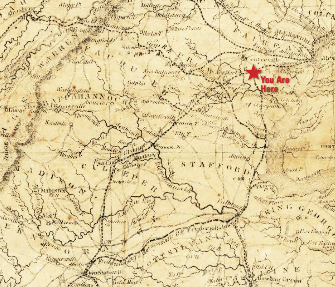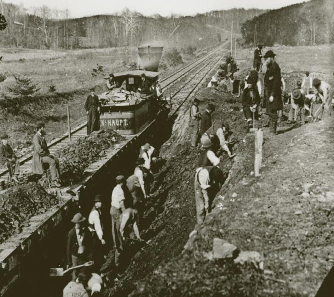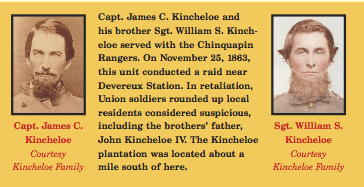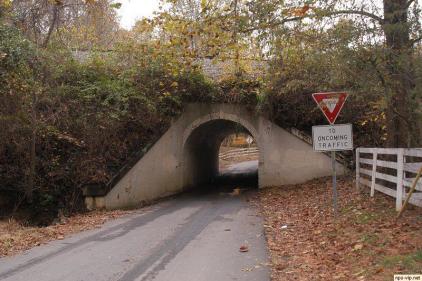
(A vintage chart of the Orange & Alexandria Railroad line through present-day Clifton and down to Culpeper. Image courtesy NPS).
It is sort of strange that one of the richest counties in America, proud Fairfax of Northern Virginia, should only have three actual towns: Herdon, Vienna and Clifton. The rest is partly historic, like Fairfax City with its courthouse, or neighborhoods composed of McMansions and connected by sprawl.
It was the first jurisdiction in America to have an average six-figure income, and ranks number three on the list of richest Counties- with Loudoun, just to the west, coming in at number one. I am thinking about visiting Bunny Man Bridge out there this weekend for a variety of perfectly good reasons, but Clifton is a special little place on the way to Refuge Farm.
It is on the way there, that is, if you are meandering. It is a bit elusive, and it is intended to be that way. Threatened by the oncoming wave of earnest bureaucrats and lobbyists seeking favors from the Imperial City, the developments were cascading west. The town council decided to restrict development, and zoned the place so that each house had to sit on at least five acres of land.
Problem almost solved- what they got was an enclave of older farmsteads and new McMansions. But it is a cute place, affectionately known as the “Brigadoon” of Virginia, as a few folks have thought perhaps it was one of those mythical places that only appears on earth for a short time, every hundred years. One thing is certain, Clifton does exist and looks very much as it did a century ago because the locals want it that way.

(Union railroad workers building the Wye at Devereux Station, now Clifton, VA. Photo NPS).
I was taking an interest in the place for a different reason, one that occurred 150 years ago, during the late unpleasantness between the states. I like connecting with my Mosby heritage- the Farm sits on the southern edge of the country where the famed Confederate guerilla operated his band of mounted brigands- or patriots, depending on your point of view.
I mentioned that the Irish Socotras were laborers on the Orange and Alexandria railroad after landing at Alexandria in 1848. The line runs through Clifton, ultimately to Richmond and points west from Orange, so I can honestly say that there is a family connection to the place.
During the war, interrupted by the 1863 requirement to pull the Union Army of the Potomac out of Northern Virginia and fight General Lee in Pennsylvania, the US Military Railroad Construction Corps built a siding there, which it named Devereux Station, in honor of Superintendent of Military Railroads, John Henry Devereux.
Devereux Siding was located between the station at Union Mills and Sangster’s Station along the O&A Line.
It was a pretty spectacular process, and rendered the landscape unrecognizable to those of us who think the scrub brush and dense trees of today are the normal landscape. Timber for railroad ties, bridge trusses, and firewood was harvested by battalions of wood-choppers and hauled by teamsters, many of whom were escaped contraband. They risked a lot operating outside the security of Union lines, and were subject to re-enslavement if captured by Rebel cavalry.
In the spring of 1863, a turn-around (known then as a “Wye,” or triangular junction) was built at Devereux Station to enable trains to reverse direction after the decision was made to abandon the O&A line south of Bull Run Creek. By June 1863 the entire railroad outside the Arlington Line was abandoned until the return of the Major General George Gordon Meade’s return from Gettysburg.
New York Infantry regiments were stationed at the siding in order to protect wood station operations and the railroad from Confederate attack.
Upon the Union’s return to the area, Gen. Herman Haupt and his Construction Corps set about repairing the road and the bridges so that the line could again be utilized for military purposes and to support the winter encampment in Culpeper during the winter of 1863-4.

The work of the Construction Corps was made difficult by the almost constant sabotage by Confederate partisan raiders. The Chinquapin Rangers, commanded at this time by Capt. James C. Kincheloe, were responsible for much of the disorder in the area of Devereux Station.
Meade issued a proclamation that thundered: “The numerous depredations committed by citizens or rebel soldiers in disguise, harbored or concealed by citizens along the Orange and Alexandria railroad, and within our lines, call for prompt and exemplary punishment… every citizen against whom there is sufficient evidence of his having engaged in these practices, will be arrested and confined for punishment or sent beyond the lines. The people within ten miles of the railroad are notified that they will be held responsible in their persons and property, for any injury done to the trains, road, depot, or stations, by citizens, guerrillas, or persons in disguise; and in case of such injury, they will be impressed as laborers, to repair all damages. If these measures should not stop such depredations, it will become the unpleasant duty of the undersigned, in the execution of his instructions, to direct that the entire inhabitants of the district or country along the railroad be put across the lines, and their property taken for Government purposes.”
– Geo. G. Meade, Major General Commanding
In mid-July 1863, the 155th NY Infantry regiment was assigned to guard duty at the Siding, to protect construction workers. Meade’s proclamation did not have much effect.
According to the sign they are going to dedicate today, “A notable engagement during this period occurred on December 17, 1863 when Confederate General Thomas Rosser’s entire brigade of about 1,000 men attacked the railroad bridge guarded by the 70 or so men of Company I. After a sharp fight in a thunderstorm in the dark, the Rebels withdrew leaving the bridge and railroad intact despite the fact the Company I was outnumbered by better than ten to one. During the fight the Confederates captured and burned the camp of Company I, leaving the men to spend several days in December without adequate clothing and shelter.”
To commemorate the dedication of the sign, there are going to be re-enactors there in the uniforms of company I, 155th NY, demonstrating how Civil War troops lived in the field, free prizes for the kids and stuff like that. Could be fun, and a chance to see a place where the family labored, briefly.
It is a little piece of history that is worth commemorating, and helps to remind me that despite the depressing things that are going on around us, there were times when it was a lot worse.
In fact, along those lines, I could tell you the ghost story about Bunny Man Bridge that commemorates several savage murders that actually didn’t happen. But we are clearly not going to get to that. The pool is open today and tomorrow at Big Pink, and I don’t care if it is raining or not.
A Man has to swim, right?

(The famous Bunny Man Bridge, allegedly the site of gruesome crimes. The Socotras helped built the railroad that crosses it, and may have helped inspire this local rhyme:
“Little bunny Foo Foo
Went hopping through the forest
Scooping up the field mice
And bopping them on the head”).
Copyright 2014 Vic Socotra
www.vicsocotra.com
Twitter: @jayare303
